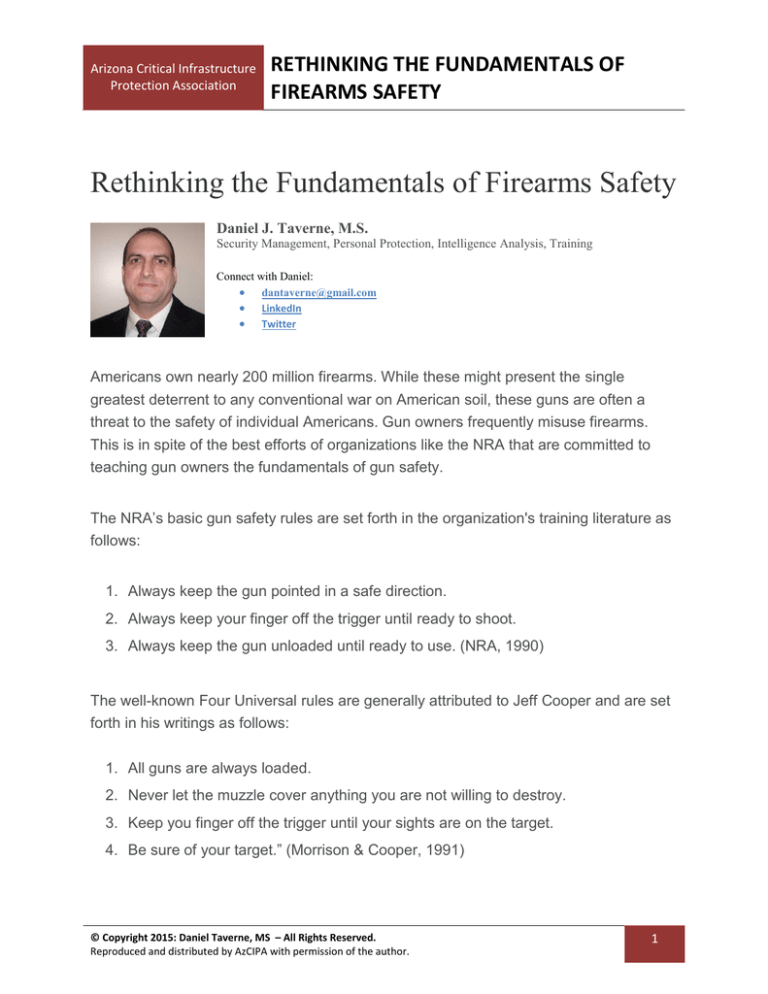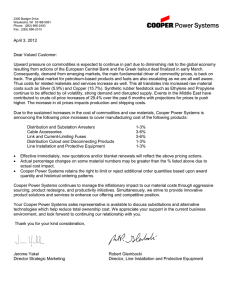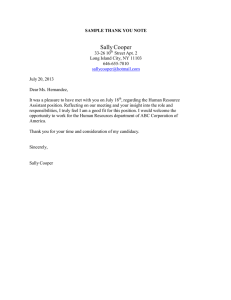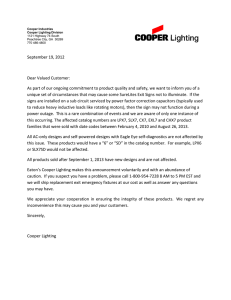
Arizona Critical Infrastructure
Protection Association
RETHINKING THE FUNDAMENTALS OF
FIREARMS SAFETY
Rethinking the Fundamentals of Firearms Safety
Daniel J. Taverne, M.S.
Security Management, Personal Protection, Intelligence Analysis, Training
Connect with Daniel:
dantaverne@gmail.com
LinkedIn
Twitter
Americans own nearly 200 million firearms. While these might present the single
greatest deterrent to any conventional war on American soil, these guns are often a
threat to the safety of individual Americans. Gun owners frequently misuse firearms.
This is in spite of the best efforts of organizations like the NRA that are committed to
teaching gun owners the fundamentals of gun safety.
The NRA’s basic gun safety rules are set forth in the organization's training literature as
follows:
1. Always keep the gun pointed in a safe direction.
2. Always keep your finger off the trigger until ready to shoot.
3. Always keep the gun unloaded until ready to use. (NRA, 1990)
The well-known Four Universal rules are generally attributed to Jeff Cooper and are set
forth in his writings as follows:
1. All guns are always loaded.
2. Never let the muzzle cover anything you are not willing to destroy.
3. Keep you finger off the trigger until your sights are on the target.
4. Be sure of your target.” (Morrison & Cooper, 1991)
© Copyright 2015: Daniel Taverne, MS – All Rights Reserved.
Reproduced and distributed by AzCIPA with permission of the author.
1
Arizona Critical Infrastructure
Protection Association
RETHINKING THE FUNDAMENTALS OF
FIREARMS SAFETY
In virtually every aspect of modern life, educators and experts have sought better
training methodologies. However, in 2010 we contacted the NRA to see what research
had been done to test the efficacy of the fundamental rules of gun safety that the
organization teaches, i.e. how memorable are they and how often to learners apply
them? The NRA representative we spoke with was unable to cite any research that had
led that organization to develop the rules it teaches or to validate the efficacy of their
methodology. C. Mitchell (personal communication, March 24, 2010)
When we contacted the experts at Gunsite, the premier firearms training organization
founded by Jeff Cooper, they too were unable to direct us to any research to validate
their use of Cooper’s Four Universal rules of gun safety. They were also unable to
describe the development of the rules. E. Head (personal communication, February 3,
2010).
We believe that Cooper’s rules are too many, too complicated, and too abstract to make
learning and retaining them possible after a short period of instruction. We believe that
the third rule in the NRA set is confusing because it leads to more questions and we
believe it does not contribute significantly to safe gun-handling.
In short, we believe the NRA's basic rules are preferable to Cooper's rules. However,
we believe the third rule in the NRA set should be omitted. We are seeking an
opportunity to compare the results when equally inexperienced groups of individuals are
taught the NRA, the Universal, and our proposed set of just two new safety behaviors.
The “Four Universal Firearms Safety Rules” are, in their present form, usually attributed
to Jeff Cooper. But in the 1961 edition of his book, The Complete Book of Modern
Handgunning, Cooper uses “[the NRA] code without reservation.” The three rules he
goes on to quote are these: (1) Treat every gun as if it were loaded. (2) Always point the
muzzle in a safe direction. (3) Be sure of your target.” (Cooper, 1961) In other words,
three of Cooper's four rules were apparently taught by the NRA at that time.
Since the time of Cooper’s 1961 book, the rules prescribed by the NRA and Cooper
himself, have undergone some evolution. The NRA’s three primary rules now read, “(1)
Always keep the gun pointed in a safe direction. (2) Always keep your finger off the
© Copyright 2015: Daniel Taverne, MS – All Rights Reserved.
Reproduced and distributed by AzCIPA with permission of the author.
2
Arizona Critical Infrastructure
Protection Association
RETHINKING THE FUNDAMENTALS OF
FIREARMS SAFETY
trigger until you are ready to shoot. (3) Always keep the gun unloaded until ready to
use.” (NRA, 1990)
Cooper’s rules evolved over the years he spent teaching at Gunsite. In 1991, Gunsite
Press published the “Four Universal Firearms Safety Rules” as follows: “(1) All guns are
always loaded. (2) Never let the muzzle cover anything you are not willing to destroy.
(3) Keep you finger off the trigger until your sights are on the target. (4) Be sure of your
target.” (Morrison & Cooper, 1991)
Cooper’s rules might be an evolution upon the basic rules presented by the NRA. Those
rules too have undergone some change. The earlier NRA rules and Cooper’s more
mature presentation both have historical predecessors. Our research shows that each
of Cooper’s “Four Universal” rules was in print many years before Cooper or Morrison
wrote anything at all on the topic.
The first rule, “All guns are always loaded,” was originally formulated as, “treat all guns
as if they are loaded.” A form of the earlier formulation of Rule #1 was in print in 1892:
“Invariably treat a gun as if loaded and full-cocked.” (Payne-Gallwey, 1892) Cooper did
make a point of the fact that he discarded the “as if” language found in the older
formulation of the rule. This nuance was important to Cooper. “‘Treat all guns as if they
were loaded.’ I do not approve of that. All guns are always loaded.” (Cooper, 1986)
Gregory Morrison offers further explanation of Cooper’s insistence upon this point:
“Unfortunately, the ‘as if’ compromises the directness of the statement by implying that
they are unloaded, but we will treat them as though they are loaded. No good! Safety
rules must be worded forcefully so that they are never treated lightly or reduced to
partial compliance.” (Morrison & Cooper, 1991)
It is apparent, however, that Cooper did “treat” his gun as unloaded when he performed
dry-fire practice. In a 1986 training video that he produced, Cooper can be seen drawing
his gun from its holster after which he declares that it’s “loaded” even though (as he
points out) the class participants saw him unload it earlier. He then performs a presscheck after which he declares the gun “unloaded” and proceeds to dry-fire it. He then
places the unloaded gun back in its holster and declares, “it’s loaded again.” (Cooper,
© Copyright 2015: Daniel Taverne, MS – All Rights Reserved.
Reproduced and distributed by AzCIPA with permission of the author.
3
Arizona Critical Infrastructure
Protection Association
RETHINKING THE FUNDAMENTALS OF
FIREARMS SAFETY
1986) Indeed, even though Cooper restated the rule, arguably making it more forceful,
he didn’t escape the fact that all guns are not always loaded. Sometimes they
are unloaded and this forcefully-stated rule will have to be broken. One has to wonder if
anything was gained by his restatement.
Cooper was aware of this debate, of course, and responded. “There are people who
insist that we cannot use this [rule #1] because it is not precisely true. Some guns are
sometimes unloaded. These folks maintain that the rule should read that one should
always treat all guns as if they were loaded. The trouble here is the ‘as if,’ which leads
to the notion that the instrument at hand may actually not be loaded.” (Cooper,
November 2003) But in the aforementioned training video it seems to the viewer that
Cooper is treating his unloaded gun as if it is loaded until he has checked it, after which
he treats it as if unloaded. This point of fiction did not escape Cooper and in 2003 he
added the following to Rule #1: “Even if they are not [loaded], treat them as if they are”
(emphasis added). (Cooper, April 2003)
The sentiment expressed in Rule #2, “Never let the muzzle cover anything you are not
willing to destroy”, was articulated in print as early as 1858. The Revolver: Its
Description, Management, and Use, discusses muzzle control thusly, “In handling a
loaded pistol, make it your invariable rule to handle it vertically; holding the muzzle
straight up or down, except when going to fire. Up is the best, for down you may shoot
yourself through the foot.” (Dove, 1858) An 1875 manual on The Pistol As a Weapon of
Defense in the House and on the Road, states, "In handling a pistol or other fire arm,
make it a rule, from which there shall never be any deviation, that, loaded or unloaded,
the muzzle shall never be pointed at any living thing whose life you do not intend to
take." (The pistol as a weapon…, 1875)
Rule 3, “Keep your finger off the trigger until your sights are on the target,” is almost a
verbatim copy of a rule published in 1920, “Never place the trigger finger within the
trigger guard until it is intended to fire and the pistol is pointing toward the target.”
(Farrow, 1920) We have been unable to find this rule or a formulation of it in any writing
prior to 1920. Also, even though this rule was published in 1920, it was apparently not
commonly taught in the early 1980s. Cooper calls this rule “a fairly new one in the
pantheon” in his 1986 Defensive Pistolcraft Tape Series. He says, “You don’t see it five
years ago.” (Cooper, 1986)
© Copyright 2015: Daniel Taverne, MS – All Rights Reserved.
Reproduced and distributed by AzCIPA with permission of the author.
4
Arizona Critical Infrastructure
Protection Association
RETHINKING THE FUNDAMENTALS OF
FIREARMS SAFETY
Rule 4, “Be sure of your target and what is behind is,” was articulated very well in 1892,
“It is a golden rule never to fire unless you can plainly see how far the shot is likely to
reach.” (Payne-Gallwey, 1892) The modern formulation of the rule differs in appearance
but not in substance.
Firearms training expert Clint Smith explains that Cooper’s rules were designed with a
combative context in mind. He says this is “the most important thing to remember” about
Cooper’s four rules. In other words, Cooper refined the rules as he considered gun
handling during a defensive or offensive fighting situation. This is not mere speculation.
Cooper wrote in his Commentaries, “Sometimes it appears we become so obsessed
with the ephemeral goal of safety that we lose sight of the purpose of the exercise.
Safety is not first. Safety is second. Victory (or success) is first.” (Cooper, ) Smith says,
“We simply use them on the range because it gives us discipline and organization.”
(Smith, 2006)
Let us turn to the third rule in the NRA's set. "Always keep the gun unloaded until ready
to use," is superfluous and confusing. Students who are new to gun-handling often ask,
“When is a gun ‘in-use’?” A lengthy conversation often follows. This confuses the
novice. But this rule is superfluous because only the first two rules are essential to keep
a negligent discharge from occurring.
Simpler and more concrete ideas are likely to be more memorable. (Heath & Heath,
2008) For this reason, the abstract and manifestly untrue rule, “All guns are always
loaded,” should be eliminated. Also, the superfluous and confusing rule, “Always keep
the gun unloaded until ready to use,” should be eliminated.
According to the NRA, positively worded rules were chosen because negatively-worded
ones contain the proscribed behavior. C. Mitchell (personal communication, March 24,
2010) This seems to accord with our intuition. For the same reason, we recommend
eliminating the rule, “Never let the muzzle cover anything you are not willing to destroy.”
(The word “muzzle” is also unfamiliar to many novices. The rule requires them to learn
© Copyright 2015: Daniel Taverne, MS – All Rights Reserved.
Reproduced and distributed by AzCIPA with permission of the author.
5
Arizona Critical Infrastructure
Protection Association
RETHINKING THE FUNDAMENTALS OF
FIREARMS SAFETY
firearms nomenclature in order to be able to follow the rule. This seems an unnecessary
complication of the rule.)
Finally, the fourth rule in the Universal set is unnecessarily redundant if guns are
“always pointed in a safe direction” and is likely to be ignored by anyone who is not
engaged in shooting (for example, if handling a gun at home where one is not shooting).
Learning is strengthened when the students can do what they are being taught.
(Medina, 2009) In other words, behaviors that can be practiced and mentally rehearsed
should be easier to learn than ideas (e.g. “all guns are always loaded” and “be sure of
your target”). Thus, we have chosen the first two rules in the NRA set and have called
them “behaviors.”
In sum, it is our belief that learning, retention, and practice of gun safety rules will be
enhanced by (1) reducing the number of rules to be learned to just two simple and
concrete ones and (2) by reclassifying and rewriting them as gun safety behaviors-things to be done, rather than things to be avoided. The Two Fundamental Gun Safety
Behaviors that we believe should be taught are:
1. Always keep the gun pointed in a safe direction
2. Always keep your finger off the trigger until you have decided to shoot.
It is our belief that people who have never before taken a formal firearm safety class will
be more likely to retain The Two Fundamental Gun Safety Behaviors and practice safe
gun-handling than similar subjects who are taught Jeff Cooper’s/theFour
Universal rules.
© Copyright 2015: Daniel Taverne, MS – All Rights Reserved.
Reproduced and distributed by AzCIPA with permission of the author.
6
Arizona Critical Infrastructure
Protection Association
RETHINKING THE FUNDAMENTALS OF
FIREARMS SAFETY
References:
Anonymous. (1875) The pistol as a weapon of defense in the house and on the road. New
York: The Industrial Publication Company
Cooper, J. (1961) The complete book of modern handgunning. Englewood Cliffs, NJ:
Prentice Hall
_____ (1986) Jeff Cooper’s defensive pistolcraft tape series. Boulder, CO: Paladin
Press
_____ (2003, April). Springtime in the boonies. Jeff Cooper’s commentaries, 11(4),
Retrieved from http://harris.dvc.org.uk/jeff/jeff11_4.html
_____ (2003, November). Thanksgiving. Jeff Coopers commentaries, 11(13), Retrieved
from http://harris.dvc.org.uk/jeff/jeff11_13.html
Dove, P.E. (1858) The revolver: its description, management, and use. Edinburgh:
Adam and Charles Black
Farrow, E.S. (1920) Farrow's manual of military training. New York: Scientific American
Pub. Co.
Heath, C. & Heath, D. (2008) Made to stick. New York: Random House
Medina, J. (2008) Brain rules. Seattle: Pear Press
Morrison, G. & Cooper, J. (1991) The modern technique of the pistol. Pauldon, AZ:
Gunsite Press
NRA Education and Training Division (1990) Home firearm safety. Fairfax, VA: NRA
Payne-Gallwey, R. (1892) Letters to young shooters on the choice and use of a gun. London:
Longman, Green, and Company
Smith C. (2006) Urban rifle, part II. Thunder Ranch training series. San Diego, CA: FMG
Publications
© Copyright 2015: Daniel Taverne, MS – All Rights Reserved.
Reproduced and distributed by AzCIPA with permission of the author.
7



